California is home to an incredible variety of deer, each adapted to its own corner of the state’s diverse landscapes — from misty redwood forests to sun-baked deserts. In this guide, we’ll explore the 8 types of deer in California, including native species like the Columbian Black-tailed Deer and Tule Elk, as well as introduced species such as Fallow Deer. You’ll learn how to identify them by their coats, antlers, and behaviors, plus discover where you’re most likely to spot them in the wild. Whether you’re a hiker, photographer, or just a curious wildlife enthusiast, this article is your friendly companion to understanding California’s graceful deer species.
1. Mule Deer (Odocoileus hemionus)
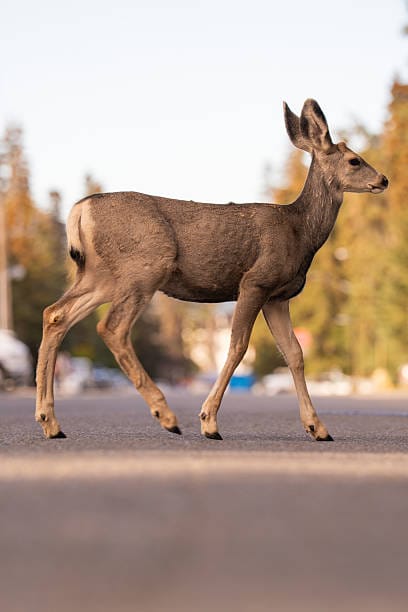
Physical Characteristics
The Mule Deer gets its name from its large, mule-like ears that swivel independently, helping it detect the faintest sounds. Adults usually weigh between 100–300 pounds, with bucks sporting forked antlers that split rather than branch from a single main beam. Their coats change color seasonally—from a tawny brown in summer to grayish in winter—perfect camouflage for the varied Californian landscapes they inhabit.
Behavior
Mule Deer are crepuscular, meaning they are most active at dawn and dusk. They have an elegant, bounding gait called “stotting,” where all four hooves lift off the ground simultaneously—a handy escape technique against mountain lions or coyotes. Unlike White-tailed Deer, Mule Deer tend to move in small groups led by cautious does, especially during fawning season.
Habitat and Range
In California, Mule Deer can be found almost everywhere except the most urbanized zones. They thrive in chaparral, oak woodlands, and mountain meadows. Populations are especially dense in the Sierra Nevada foothills and northern coastal ranges, where moderate winters and ample forage sustain them year-round.
Diet
They browse on shrubs, leaves, acorns, and tender shoots rather than grazing on grass. When food is scarce, they can survive on twigs and bark—nature’s tough salad bar. They’re also known to nibble on ornamental gardens when natural forage is low, much to the dismay of suburban homeowners.
Reproduction and Life Cycle
Breeding takes place in late autumn. Bucks fight for dominance, locking antlers in spectacular duels that echo through the hills. After a gestation of about 200 days, does give birth to one or two fawns in spring. Fawns are born with spotted coats that provide camouflage from predators. They stay hidden for the first few weeks of life while their mothers forage nearby.
Fun Facts / Unique Traits
One fun fact: Mule Deer can see ultraviolet light, giving them a sharper view at dawn and dusk. Their oversized ears also work as heat regulators during California’s scorching summers.
Human Interaction
Humans have a long history with Mule Deer—from indigenous hunting traditions to modern wildlife management. Unfortunately, vehicle collisions and habitat loss are growing concerns. Still, many Californians cherish their sighting of a Mule Deer grazing near trails, a timeless reminder of wild California.
2. Columbian Black-tailed Deer (Odocoileus hemionus columbianus)
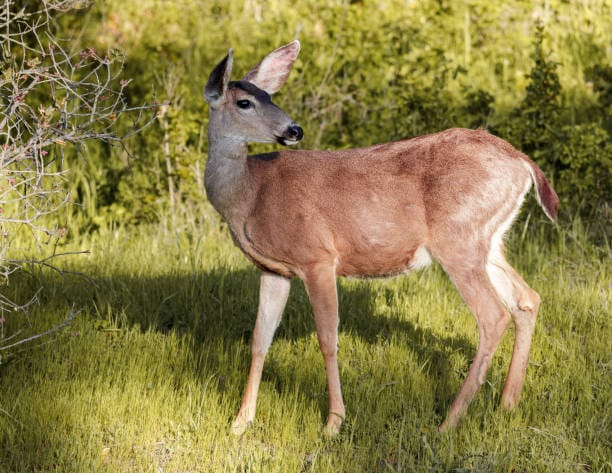
Physical Characteristics
This subspecies of Mule Deer is native to the Pacific Northwest and thrives along California’s northern coast. Slightly smaller than typical Mule Deer, the Columbian Black-tailed Deer is known for its chocolate-brown back and jet-black tail tip. Bucks carry wide, symmetrical antlers, though less forked than their inland cousins.
Behavior
These deer are stealthy forest dwellers. They prefer staying under dense canopy cover and are excellent swimmers—sometimes crossing rivers to reach new feeding grounds. During the rut, bucks become highly territorial, marking their range with scent glands and challenging rivals in dramatic stand-offs.
Habitat and Range
Black-tailed Deer dominate the fog-laden redwood and Douglas-fir forests of northern California. They are particularly abundant in Humboldt, Mendocino, and Del Norte counties. Unlike desert or mountain deer, they seldom migrate far, relying on the coastal climate’s mildness year-round.
Diet
They feed mainly on berries, mushrooms, and leafy vegetation. The abundance of moisture along the coast supports a constant buffet of greenery, allowing them to stay in relatively small home ranges.
Reproduction and Life Cycle
Does give birth in late spring after a 200-day gestation, usually to twins. The fawns’ spotted coats help them vanish in dappled forest light. Bucks shed and regrow their antlers annually, covered in velvety tissue that’s shed by summer’s end.
Fun Facts / Unique Traits
The Columbian Black-tailed Deer has an almost magnetic homing sense—many tagged individuals have been documented returning to their birthplace even after being relocated miles away.
Human Interaction
They’re often spotted along coastal hiking trails, much to the delight of wildlife photographers. Conservation efforts are focused on balancing deer populations with predator recovery, especially as cougar sightings rise in northern counties.
3. White-tailed Deer (Odocoileus virginianus)

Physical Characteristics
Although less common in California, the White-tailed Deer remains one of North America’s most iconic animals. Characterized by its slender build, reddish summer coat, and snow-white underside of the tail, it can weigh between 100–250 pounds. When alarmed, it flashes its namesake tail like a flag before bounding away.
Behavior
White-tails are skittish and alert, relying on sharp hearing and scent detection to avoid predators. They are highly adaptive—capable of living in forests, farmlands, and even suburban parks. They communicate with tail flicks, grunts, and stamping hooves, signaling danger to others nearby.
Habitat and Range
In California, White-tailed Deer are mostly limited to far northern and eastern regions bordering Oregon and Nevada. Their populations are small but stable, often inhabiting mixed conifer forests and riparian zones where water is plentiful.
Diet
They are versatile feeders, consuming leaves, nuts, fruits, and grasses. Their varied diet allows them to adapt easily to seasonal shifts, making them resilient survivors even in fragmented habitats.
Reproduction and Life Cycle
The rut occurs in late fall, with bucks engaging in sparring contests. After a 6- to 7-month gestation, does give birth to one to three fawns. The young remain hidden for several weeks until strong enough to join their mother in foraging.
Fun Facts / Unique Traits
White-tailed Deer can run up to 35 mph and leap nearly 10 feet high. Their tails serve as both a warning flag and a communication tool—an evolutionary advantage that’s saved many from predators.
Human Interaction
Encounters are rare in California, but where they do occur, these deer tend to coexist peacefully near rural properties. Conservation groups monitor them to prevent hybridization with Mule Deer, preserving each species’ genetic line.
4. Inyo Mule Deer (Odocoileus hemionus inyoensis)
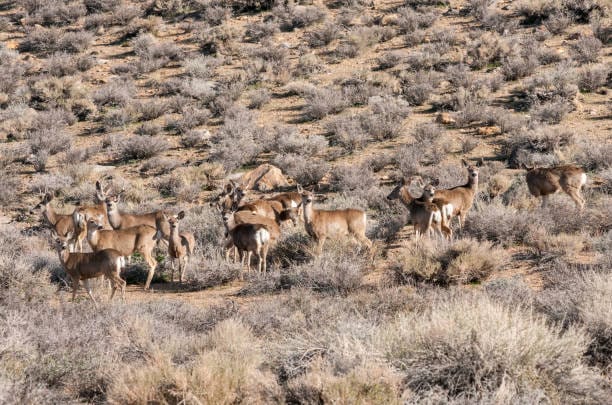
Physical Characteristics
The Inyo Mule Deer is a hardy desert-dweller found mainly in the eastern Sierra and Inyo Mountains. It’s smaller and leaner than its northern cousins, built for life in rugged, dry terrain. Its coat takes on a sandy-gray tone, blending perfectly with the sagebrush and rocky hillsides it calls home. Bucks have relatively modest antlers compared to other Mule Deer, often more compact and curved.
Behavior
This deer has a nomadic spirit. Seasonal migrations take it from the high-elevation summer ranges down to the low desert valleys during winter. They travel in small, tight-knit groups—often led by an experienced doe who knows every water source and escape route. Despite the harsh surroundings, they display surprising agility, scaling rocky slopes that would leave most animals breathless.
Habitat and Range
The Inyo Mule Deer’s territory covers parts of Inyo County, Mono County, and the eastern slopes of the Sierra Nevada. You’ll often find them near desert springs, pinyon pine forests, or sagebrush flats. These deer are the true survivalists of California’s interior, thriving where vegetation is sparse and temperatures fluctuate wildly.
Diet
They mainly feed on sagebrush, bitterbrush, juniper berries, and desert shrubs. During the short spring bloom, they eagerly munch on fresh grasses and wildflowers. Water is scarce, but they can extract moisture from succulent plants, allowing them to go days without visiting a waterhole.
Reproduction and Life Cycle
The rut occurs from November to early December. After a 200-day gestation, fawns are born in late spring—timed perfectly with the emergence of green shoots. The young are particularly vulnerable to coyotes, so mothers often hide them among sage clumps during the day.
Fun Facts / Unique Traits
Inyo Mule Deer have been known to migrate over 60 miles between summer and winter ranges. Some herds even cross highways and dry basins during their annual trek—a testament to their endurance and instinctive memory.
Human Interaction
These deer face increasing challenges from habitat fragmentation and highway traffic. Conservation programs in Inyo County have introduced wildlife overpasses and corridors to reduce collisions. For desert hikers, spotting an Inyo Mule Deer in the wild is like finding a rare gem in the sand—quiet, fleeting, and unforgettable.
5. Desert Mule Deer (Odocoileus hemionus crooki)

Physical Characteristics
The Desert Mule Deer, sometimes called the “ghost of the desert,” has adapted beautifully to California’s arid southern regions. It’s typically smaller and paler than other subspecies, sporting a light gray-tan coat that reflects sunlight. The large ears—proportionally even bigger than the typical Mule Deer—help radiate excess heat.
Behavior
Life in the desert is no easy ride. These deer are crepuscular, venturing out mainly during dawn and dusk to avoid extreme heat. During daylight, they seek shade under mesquite trees or boulders, conserving precious energy and moisture. Socially, they tend to form small groups, often consisting of related females and their young.
Habitat and Range
The Desert Mule Deer inhabits the southeastern corner of California—especially in the Mojave Desert and along the Colorado River corridor. Their range overlaps with that of Bighorn Sheep and Coyotes, making them part of a delicate desert ecosystem finely tuned to scarcity.
Diet
These deer feed mainly on cactus pads, mesquite beans, desert willows, and other drought-resistant plants. They can metabolize moisture directly from their food, reducing the need for standing water. During droughts, they may travel miles to visit springs or artificial water catchments maintained by conservationists.
Reproduction and Life Cycle
Desert Mule Deer mate in late fall. Fawns are born in late spring when temperatures are slightly milder. The mothers are fiercely protective, often leading fawns to shaded ravines where they remain nearly invisible to predators like bobcats or golden eagles.
Fun Facts / Unique Traits
They can survive weeks without direct water intake. Instead, they rely on the moisture-rich pulp of desert succulents—a hydration trick that would make even camels envious.
Human Interaction
Encounters are rare due to their elusive habits, but Desert Mule Deer occasionally wander near desert towns or golf courses in search of water. Habitat conservation projects, such as desert wildlife guzzlers, are helping maintain their fragile populations.
6. Southern Mule Deer (Odocoileus hemionus fuliginatus)

Physical Characteristics
Native to Southern California, this subspecies stands out for its darker, almost chocolate-colored coat. Bucks can weigh up to 200 pounds and grow impressive forked antlers. Their tails are thin and black-tipped, and their eyes carry that classic “wide-eyed curiosity” that photographers love.
Behavior
Southern Mule Deer are more tolerant of human presence than most deer. They’re often seen grazing near suburban edges, vineyards, or parklands. However, they remain cautious, freezing motionless when they sense danger before bounding away in elegant leaps.
Habitat and Range
This deer is found throughout the coastal ranges and chaparral of Southern California—from Ventura and Los Angeles counties down to San Diego. They prefer rolling hills and oak-dotted valleys, but some herds venture surprisingly close to city limits, thriving in greenbelts and canyons.
Diet
Like other Mule Deer, they are browsers, eating twigs, acorns, leaves, and the occasional cactus fruit. Their ability to digest fibrous, low-nutrient vegetation makes them perfectly suited to Southern California’s Mediterranean climate.
Reproduction and Life Cycle
Does give birth to one or two fawns in early summer. Fawns are hidden for several weeks before joining the herd. Males shed antlers in winter, then regrow them during spring, covered with a velvet layer that nourishes their growth.
Fun Facts / Unique Traits
Southern Mule Deer are known for their remarkable jumping ability—they can clear 8-foot fences effortlessly. This athleticism often leads to surprise visits in people’s backyards!
Human Interaction
These deer live close to human developments, which means car collisions and garden raids are common. Nonetheless, they’ve become a familiar sight to many Californians, embodying the wild spirit that persists even amid urban sprawl.
7. Fallow Deer (Dama dama)
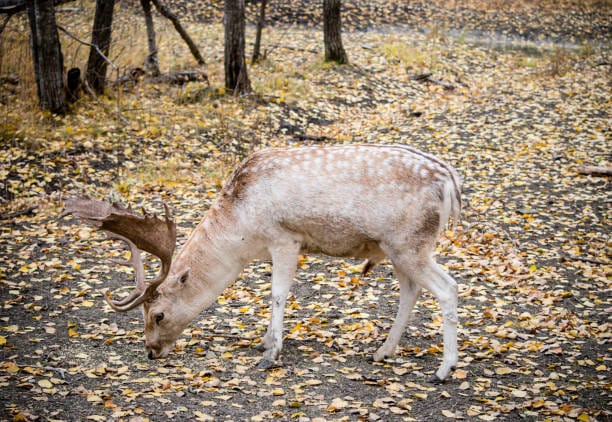
Physical Characteristics
Though not native to California, the Fallow Deer has established several feral populations across private ranches and preserves. They are easily recognized by their spotted coats and broad, palm-shaped antlers that resemble miniature moose racks. Their color variations—ranging from white to chestnut to dark brown—add to their striking appearance.
Behavior
Fallow Deer are highly social animals that form large herds, especially outside the breeding season. Bucks engage in vocal duels called “groaning contests,” which sound like deep grunts echoing across open meadows. They’re also known for their curious nature—less shy than native species, often approaching humans at a safe distance.
Habitat and Range
In California, small Fallow Deer populations exist on private estates, hunting preserves, and isolated parks. They thrive in open woodlands and grasslands, particularly in Central California’s rolling hills.
Diet
They graze on grasses and herbs but also browse leaves and fruits. Their diet flexibility makes them successful in semi-managed habitats, where natural food sources may vary seasonally.
Reproduction and Life Cycle
The rut occurs in October. Bucks establish small territories called “leks,” where they display for females through loud groaning and antler posturing. Fawns are born in June after a 230-day gestation. Mothers are attentive, often hiding newborns in tall grass for protection.
Fun Facts / Unique Traits
Fallow Deer were originally brought to California by European settlers as ornamental game animals. Their distinctive antlers make them a favorite among wildlife photographers and park visitors alike.
Human Interaction
Most Fallow Deer in California live under managed or semi-wild conditions. While they’re not part of the native ecosystem, they’ve integrated well without posing major threats to local wildlife.
8. Tule Elk (Cervus canadensis nannodes)
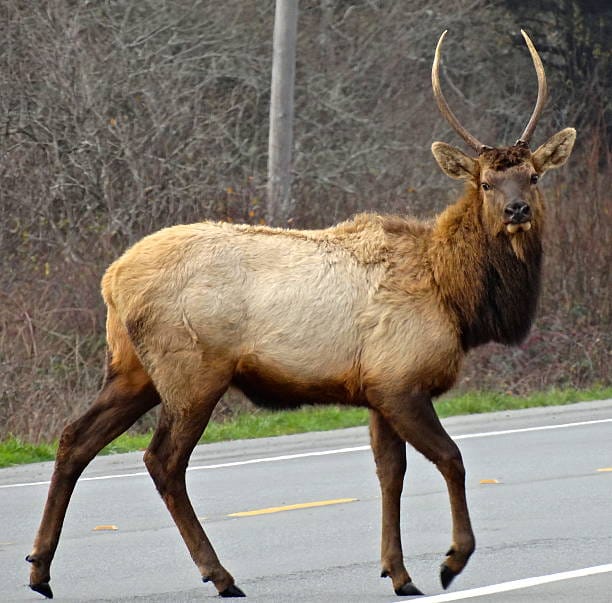
Physical Characteristics
The Tule Elk isn’t technically a deer—but it’s close enough to deserve a spot here. This subspecies of elk is native to California and is smaller than its Rocky Mountain relatives. Bulls can weigh up to 700 pounds, sporting impressive antlers that can span over four feet wide. Their coats shift from tawny gold in summer to dark brown in winter.
Behavior
Tule Elk are calm and curious grazers, often seen in open grasslands. During the rut, bulls bugle—a haunting, high-pitched call that carries for miles. They use this sound to attract females and warn off rivals. Outside breeding season, herds are segregated by sex, with females forming maternal groups and males banding together in bachelor herds.
Habitat and Range
Once near extinction, Tule Elk now thrive in protected areas like Point Reyes National Seashore and the Carrizo Plain. They prefer wide-open spaces with plenty of grasses and water sources. Their population recovery is one of California’s great wildlife success stories.
Diet
They feed primarily on grasses, sedges, and forbs. During dry spells, they may browse shrubs or tree bark. Their digestive systems are efficient, allowing them to extract nutrients from coarse vegetation that most deer would ignore.
Reproduction and Life Cycle
The rut begins in late summer. Bulls compete for harems of cows, engaging in antler clashes that echo across the plains. Calves are born in late spring and can stand within an hour of birth—proof that life in open country demands a fast start.
Fun Facts / Unique Traits
The Tule Elk is named after the tule reeds that once blanketed California’s Central Valley. Remarkably, all modern herds descend from fewer than 30 individuals—rescued from near extinction in the 1800s.
Human Interaction
Tule Elk conservation is a California success story. They were reintroduced into several regions and now attract thousands of wildlife enthusiasts annually. Their presence reminds us that with care and persistence, even lost species can make a triumphant return.
Final Thoughts
From the mountain-dwelling Mule Deer to the desert-adapted Inyo and the regal Tule Elk, California’s deer species showcase an incredible spectrum of adaptability and grace. Observing them is like peering into nature’s living artwork—each antler curve and hoofprint telling a story of survival. Whether you spot one while hiking through the redwoods or crossing a sunlit meadow, remember: these gentle wanderers are living proof that wild California is still very much alive.
FAQ’s
1. How many types of deer are there in California?
California is home to two main species of deer: the Mule Deer (Odocoileus hemionus) and its coastal subspecies, the Columbian Black-tailed Deer. Across the state, there are several regional subspecies adapted to different habitats, such as the California Mule Deer and the Southern Mule Deer.
2. What kind of deer are in southern California?
Southern California is mainly inhabited by the Southern Mule Deer, a smaller subspecies of Mule Deer. These deer are well adapted to arid hills, deserts, and chaparral landscapes across the region.
3. Are there mule deer in California?
Yes. Mule Deer are the most widespread deer species in California, thriving in forests, foothills, and even semi-desert regions from the Sierra Nevada to the coastal ranges.
4. What is the difference between a mule deer and a blacktail deer in California?
The main difference lies in their range and physical traits. Black-tailed Deer live mostly in the coastal and northern forests, featuring darker coats and smaller ears. Mule Deer are found more inland and are slightly larger with lighter coloration and distinct mule-like ears.
5. Are there big deer in California?
Yes, but compared to states like Montana or Texas, California’s deer tend to be medium-sized. However, mature Mule Deer bucks in the Sierra Nevada can weigh up to 200 pounds and grow impressive antlers.
6. What is the most common deer in California?
The most common deer in California is the Mule Deer, particularly the Columbian Black-tailed Deer subspecies along the coast and the California Mule Deer subspecies inland.
7. Are reindeer native to California?
No, reindeer (also called caribou) are not native to California. They live in northern regions such as Alaska, Canada, and Scandinavia. Any reindeer found in California are part of private farms or zoos.
8. Why is California’s deer population so low?
Deer numbers in California have declined due to habitat loss, wildfires, drought, and reduced food sources. Predation by mountain lions and vehicle collisions have also contributed to lower populations in some regions.
9. What is the top predator in California?
The mountain lion (also known as cougar or puma) is California’s top predator. These powerful cats play a key role in controlling deer populations and maintaining ecological balance.
10. How many elk are in California?
California has around 12,000 elk across three species: Roosevelt Elk, Tule Elk (found only in California), and Rocky Mountain Elk. Tule Elk are the most unique, living mainly in grasslands and wetlands of central California.
11. Is there moose in California?
No, moose are not native to California. Their range is limited to northern states such as Alaska, Montana, and Idaho, where colder climates suit them better.
12. Can you shoot elk in California?
Yes, elk hunting is allowed in California but only through a limited permit system managed by the California Department of Fish and Wildlife (CDFW). Tags are issued through a lottery due to the small and protected elk populations.
13. Can I shoot a deer on my property in California?
You can legally hunt deer on your property in California only during open hunting seasons and with a valid hunting license and deer tag. You must also follow firearm and safety regulations set by the CDFW.
Conclusion
California’s deer population tells a story as rich and varied as the state’s geography itself. From the rugged mountain-dwelling Mule Deer to the iconic Columbian Black-tailed Deer along the Pacific Coast, and the once-endangered Tule Elk thriving in restored wetlands — each species plays a vital role in keeping local ecosystems balanced. Whether you encounter them while hiking a redwood trail, driving through golden foothills, or camping in high desert country, these graceful animals remind us that wild beauty still thrives alongside human life.
If you ever find yourself wandering the backroads of California, take a quiet moment and look carefully — a flicker of white tail or a pair of alert ears might be watching you from the brush. Respect their space, appreciate their presence, and let the wilderness show you its calm, timeless rhythm — one deer at a time.
